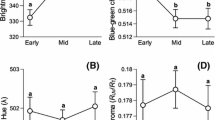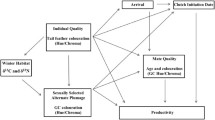Abstract
We used a brood-size manipulation to test the effect of rearing environment on structural coloration of feathers grown by eastern bluebird (Sialia sialis) nestlings. Ultraviolet (UV)-blue structural coloration has been shown to be sexually selected in this species. Our experimental design took advantage of the growth of UV-blue wing feathers in nestlings that are retained as part of the first nuptial plumage. We cross-fostered nestlings to create enlarged and reduced broods with the purpose of manipulating parental feeding rates and measured the effect on nestling growth and plumage coloration. Brood size influenced feeding rates to offspring, but the effect varied with season. In general, male nestlings reared in reduced broods were fed more often, weighed more, and displayed brighter structural plumage compared to nestlings reared in enlarged broods. Female nestlings appeared to experience less adverse affects of brood enlargement, and we did not detect an effect of brood-size manipulation on the plumage coloration of female nestlings. Measures of plumage coloration in both males and females, however, were correlated to hatching date and nestling mass during feather development. These data provide empirical evidence that environmental quality can influence the development of the blue structural coloration of feathers and that males may be more sensitive to environmental fluctuations than females.



Similar content being viewed by others
References
Cotton S, Fowler K, Pomiankowsi A (2004) Do sexual ornaments show heightened condition-dependence expression as predicted by the handicap hypothesis? Proc R Soc Lond B 771:78
Engqvist L (2005) The mistreatment of covariate interaction terms in linear model analyses of behavioral and evolutionary ecology studies. Anim Behav 967–971
Fisher RA (1930) The genetical theory of natural selection. Oxford Univ Press, Oxford
Fridolfsson A-K, Ellegren H (1999) A simple and universal method for molecular sexing of non-ratite birds. J Avian Biol 30:116–121
Gowaty PA, Plissner JH (1998) Eastern bluebird, Sialia sialis. In: Poole A, Gill GP (eds) Birds of North America no. 381. The Birds of North America, Philadelphia, PA, pp 1–32
Hamilton W, Zuk M (1982) Heritable true fitness and bright birds: a role for parasites? Science 218:384–387
Hill GE (2006) Environmental regulation of ornamental coloration. In: Hill GE, McGraw KJ (eds) Bird coloration vol. I: mechanisms and measurements. Harvard Univ Press, Cambridge, MA, pp 507–560
Hill GE, Doucet SM, Buchholz R (2005) The effect of coccidial infection on iridescent plumage coloration in wild turkeys. Anim Behav 69:387–394
Jacot A, Kempenaers B (2007) Effects of nestling condition on UV plumage traits in blue tits: an experimental approach. Behav Ecol 18:34–40
Johnsen A, Delhey K, Andersson S, Kempenaers B (2003) Plumage colour in nestling blue tits: sexual dichromatism, condition dependence and genetic effect. Proc R Soc Lond B 270:1263–1270
Kodric-Brown A, Brown J (1984) Truth in advertising: the kinds of traits favored by sexual selection. Am Nat 124:309–323
Liu M, Siefferman l, Hill GE (2007) An experimental test of female choice relative to male structural coloration in eastern bluebirds. Behav Ecol Sociobiol 61:623–630
McGraw KJ, Mackillop EA, Dale J, Hauber ME (2002) Different colors reveal different information: how nutritional stress affects the expression of melanin and structurally based ornamental plumage. J Exp Biol 205:3747–3755
Peters A, Delhey K, Johnsen A, Kempenaers B (2007) The condition-dependent development of carotenoid-based and structural plumage in nestling blue tits: males and females differ. Am Nat 169:S122–S136
Pinkowski B (1975) Growth and development of eastern bluebirds. Bird-band 46:273–289
Prum RO (2006) Anatomy, physics and evolution of avian structural colours. In: Hill GE, McGraw KJ (eds) Bird coloration vol. I: mechanisms and measurements. Harvard Univ Press, Cambridge, MA, pp 295–353
Qvarnström A, Price TD (2001) Maternal effects, paternal effects and sexual selection. Trends Ecol Evol 16:95–100
Shawkey MD, Estes AM, Siefferman LM, Hill GE (2003) Nanostructure predicts intraspecific variation in structural plumage colour. Proc R Soc Lond B 270:1455–1460
Shawkey MD, Estes AM, Siefferman LM, Hill GE (2005) The anatomical basis for sexual dichromatism in non-iridescent ultraviolet-blue colouration of feathers. Biol J Linn Soc 84:259–271
Siefferman L, Hill GE (2003) Structural and melanin plumage coloration indicate parental effort and reproductive success in male eastern bluebirds. Behav Ecol 14:855–861
Siefferman L, Hill GE (2005a) Evidence for sexual selection on structural plumage coloration in female eastern bluebirds. Evolution 59:1819–1828
Siefferman L, Hill GE (2005b) UV-blue structural coloration and competition for nest boxes in male eastern bluebirds. Anim Behav 69:67–72
Siefferman L, Hill GE (2005c) Male eastern bluebirds trade future ornamentation for current reproductive investment. Biol Lett 1:208–211
Siefferman L, Hill GE, Dobson S (2005) Ornamental plumage coloration and condition are dependent on age in eastern bluebirds Sialia sialis. J Avian Biol 36(5):428–435 DOI 10.1111/j.0908-8857.2005.03401.x
Trivers RL, Willard DE (1973) Natural selection of parental ability to vary sex-ratio of offspring. Science 179:90–92
Tschirren B, Fitze PS, Richner H (2003) Sexual dimorphism in susceptibility to parasites and cell-mediated immunity in great tit nestlings. J Anim Ecol 72:839–845
Wolf JB, Brodie III ED, Moore AJ (1999) The role of maternal and paternal effects in the evolution of parental quality by sexual selection. J Evol Biol 12:1157–1167
Zahavi A (1975) Mate selection—a selection for a handicap. J Theor Biol 53:205–214
Acknowledgments
We thank E. Gering, T. Robinson, and B. Staton for field assistance and C. Ariail, A. King, and H. Mays Jr. for laboratory assistance. We are grateful to R. Montgomerie for the use of his spectral processing program, to I. Cuthill and J. McGlothlin for statistical advice, and to M. Liu for comments on the manuscript. This research was conducted according to an animal use permit from Auburn University, banding permits to GEH, and complies with the laws of the USA. Funding came from NSF grants IBN 9722171, IBN 0235778, DEB 0077804 to GEH, a NSF-NIH grant R01-AI49724 to GEH and American Ornithological Union, Animal Behaviour Society, and Birmingham Audubon Society grants to LS.
Author information
Authors and Affiliations
Corresponding author
Additional information
Communicated by I. Cuthill
Rights and permissions
About this article
Cite this article
Siefferman, L., Hill, G.E. The effect of rearing environment on blue structural coloration of eastern bluebirds (Sialia sialis). Behav Ecol Sociobiol 61, 1839–1846 (2007). https://doi.org/10.1007/s00265-007-0416-0
Received:
Revised:
Accepted:
Published:
Issue Date:
DOI: https://doi.org/10.1007/s00265-007-0416-0




